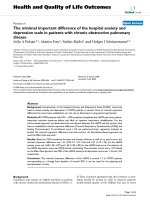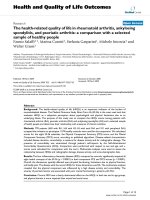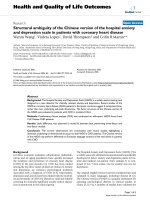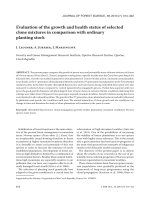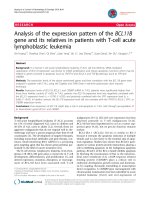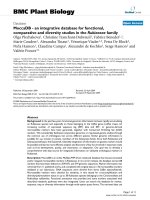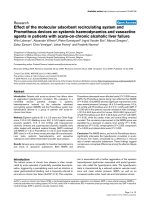Promoting Cultural Identity Within the Curriculum of the University of Languages and International Studies (in Comparison with that of the University of Social Sciences and Humanities)
Bạn đang xem bản rút gọn của tài liệu. Xem và tải ngay bản đầy đủ của tài liệu tại đây (115.47 KB, 5 trang )
<span class='text_page_counter'>(1)</span><div class='page_container' data-page=1>
65
Promoting Cultural Identity Within the Curriculum of the
University of Languages and International Studies
(in Comparison with that of the University
of Social Sciences and Humanities)
Trần Minh Toàn
*<i>VNU University of Languages and International Studies, </i>
<i>144 Xuân Thủy Street, Cầu Giấy Dist, Hànội,Việtnam </i>
Received 15 September 2013
Revised 3 October 2013; Accepted 15 December 2013
<b>Abstract: First of all, this paper deals with the definition of “international studies” and its </b>
implications as well as different approaches in the world to this concept. Next, the author examines
in details the differences in the curricula of the University of Languages and International Studies
and the University of Social Sciences and Humanities as far as International Studies is concerned.
Why the University of Languages and International Studies should focus its curriculum on culture
rather than economy, politics or social and religious issues as the pillars of international studies
represents the main content of this article. In addition to this, the author also briefly looks into the
fact that unlike the curriculum of the University of Languages and International Studies, that of the
University of Social Sciences and Humanities focuses on the political aspect of international
studies. Finally, the author comes up with some suggestions on how to improve the current
curricula of the 2 universities regarding International Studies.
<i>Keywords:</i> Cultural identity, curriculum, University of Languages and International Studies,
<b>University of Social Sciences and Humanities. </b>
<b>1. Introduction*</b>
International Studies courses are widely
taught at different universities around the
world, including those in Vietnam. However,
sad as it is, many of these courses fail to come
up with their own definitions of “international
studies”. That is the case with the University of
Languages and International Studies as well as
_______
*<sub> Tel: 84-0968893013 </sub>
Email:
the University of Social Sciences and
Humanities even though the latter specializes
in this field.
<b>2. A definition of International Studies and </b>
<b>different approaches </b>
</div>
<span class='text_page_counter'>(2)</span><div class='page_container' data-page=2>
social, and cultural issues that dominate the
international agenda” [7]. The term itself can
be more specifically defined as “the
contemporary and historical understanding of
global societies, cultures, languages and
systems of government and of the complex
relationships between them that shape the
world we live in” [2].
Different countries in the world have
different approaches to international studies.
As far as this article is concerned and in
relation to the research undertaken by this
article, the author only mentions the
approaches to international studies of
Australia, the UK and the US and finally,
Vietnam.
The study of the International Studies
discipline in Australia occurs mostly within
universities, which generally approaches the
subject as a holistic study of international
affairs and phenomena. The study is also
offered in some Australian high schools. The
Victorian Certificate of Education (VCE)
system, operating within Victoria, offers
International Studies as an elective to year 12
students [6]. The two units offered in
International Studies VCE are “Global issues and
conflicts’ and ‘International Relations” [6].
In the UK, international Studies is often
related to or attached to the study of
International Relations. At the University of
Oxford, “the Centre for International Studies
exists to promote and advance research in
International Relations" [4]. In this sense the
use of the term International Studies differs to
that of the Australian use of the term in that it
is tied to the discipline of International
Relations, rather than addressing them as
separate entities.
In the US, there exist a number of
institutions which promote International
Studies in the United States of America. The
Centre for Strategic and International Studies
is a foreign policy think tank which aims to
“provide strategic insights and policy solutions
to decision makers in government,
international institutions, the private sector,
and civil society” [1]. The Freeman Spogli
Institute for International Studies is a research
center based at Stanford University which is a
“primary center for innovative research on
major international issues and challenges” [3].
Both institutions focus primarily on the study
of international affairs and relations in relation
to US foreign policy, and therefore differ to the
Australian approach to International Studies.
Alternatively, the undergraduate International
Studies program at St. John Fisher College in
Rochester, New York is a holistic program that
more closely follows the Australian model.
The International Studies discipline is
usually offered as either part of an arts degree
or as a specialist arts degree. As such, students
are able to select from a very broad range of
subjects to undertake. Following are some
areas of study which are regularly and
generally offered [2]:
+ The political, social, economic and
cultural relationships within the international
system
+ Foreign policy, diplomacy and other
modes of interaction between the countries of
the world
+ The significance of foreign societies,
cultures and systems of government
+ The international movement of people as
immigrants, refugees, workers, students,
tourists and investors
+ The role of international organizations
+ The globalization of the world economy
+ Foreign languages
</div>
<span class='text_page_counter'>(3)</span><div class='page_container' data-page=3>
International Studies include Country
Studies. In other words, Country Studies forms
part of International Studies and is a branch of
International Studies. This is understandable
because each country is regarded as a cell of
the international community. When we look
into the international community, we need to
look into its cells, i.e. the countries involved.
On the basis of the analysis above, we can
safely draw some conclusions regarding
International Studies. First, the terms and
concepts of International Studies and
international relations are strongly related.
However, international relations focus more
directly on the relationship between countries,
whereas International Studies can encompass
all phenomena which are globally orientated.
Second, there are 2 current trends in
International Studies teaching in the world as
well as in Vietnam at the moment. The first
trend mostly relates to politics while the other
is predominantly relevant to linguistics. It
should be noted here that international
relations represent external politics.
<b>3. Promoting cultural identity within the </b>
<b>International Studies curriculum of the </b>
<b>University of Languages and International </b>
<b>Studies </b>
At the University of Languages and
International Studies and the University of
Social Sciences and Humanities, many
subjects within the domain of International
Studies are taught. Due to the limited extent of
this paper, the author could only discuss the
subjects that are taught in English at the
University of Languages and International
Studies. The question is: as the member
universities of the Vietnam National
University, do the curricula of these 2
universities with regard to International
Studies overlap to a certain extent? The answer
is “no”. There are indeed some differences
between them that need to be taken into
account. First, the subjects relating to
International Studies at the University of
Languages and International Studies are taught
in foreign languages. That’s why both teachers
and students approach the International Studies
discipline from the perspective of linguistics.
Besides, it must be stressed that International
Studies constitute one of the 2 branches of
teaching that are undertaken at the University
of Language and International Studies. The
other branch is linguistics and that’s why the
university gets the name “University of
Languages and International Studies”. The
University of Languages and International
Studies is composed of 11 faculties. The
author of this paper is working at the Faculty
of Linguistics and Culture of English Speaking
countries, which is composed of 3 divisions:
Country Studies, English Linguistics, and
Literature and Cross-culture Communication.
For that reason and due to the limited extent of
this article, the author can only discuss the
subjects taught at this faculty, or to be more
specific, at the division of Country Studies.
By comparison, judging by the curriculum
of the University of Social Sciences and
Humanities [5], it seems the university
specializes in politics, or to be more specific,
international relations. About 50% of the
subjects focus on this domain. The remaining
subjects are to do with economy, culture,
history, social and religious issues.
</div>
<span class='text_page_counter'>(4)</span><div class='page_container' data-page=4>
culture and social issues. So, culture
constitutes one of the four pillars of
International Studies. Culture is an essential
components of International Studies, but that
doesn’t mean the 3 remaining components are
less significant. In fact, they are all
interdependent and complement each other. And
now, it’s time to turn to the main content of this
paper: why should the University of Languages
and International Studies promote cultural
identity in its curriculum or in other words, why
should the curriculum of the University of
Languages and International Studies focus on
culture rather than any other pillars?
As we all know, linguistics and culture are
closely connected. In fact, linguistics represent
and form part of culture. If the culture of a
country is likened to a house, then its language(s)
constitute(s) its door(s). We can only enter a
house if we cross its door(s). From that
perspective, languages represent a means to
discover and explore the culture of a country.
That’s the first reason that explains why the
University of Languages and International
Studies should focus its International Studies
curriculum on culture. That’s an inevitable
development trend and also a future orientation
for the university.
Secondly, the curriculum of the University of
Social Sciences and Humanities, as mentioned
above, focuses on politics. As another member of
the Vietnam National University, the University
of Languages and International Studies should
definitely focus its curriculum on culture if the
latter doesn’t want its curriculum to overlap with
that of the University of Social Sciences and
Humanities. Focusing on other pillars other than
culture, that is to say politics, economy or social
issues, is absolutely not a good and wise choice
for the university.
Thirdly, studying cultures is a good way to
enrich the national culture and the so-called
“individual culture”. In other words,
discovering and exploring cultures helps you
become more cultured and refined and thus
helps to improve yourself in different ways.
</div>
<span class='text_page_counter'>(5)</span><div class='page_container' data-page=5>
making students remember as many facts and
figures as possible, teachers should ask their
students to think “culturally”.
However, a lot still needs to be done so as
to focus the International Studies curriculum
more and more on culture. Besides the
measures and solutions that have already been
mentioned above, the University of Languages
and International Studies should map out a
clear teaching schedule for the 13 remaining
subjects. When their textbooks should be
finalized and when they would be officially
taught should be stipulated. The university
should attach much more importance to those
subjects that seem more significant than others,
including: Cultures of Southeast Asian
countries; Regional organizations and the
trends for international cooperation;
Globalization and its impacts on contemporary
societies; The current position of China in Asia
and the world; A comparison of Eastern and
Western cultures.
As for the curriculum of the University of
Social Sciences and Humanities, the author
would like to make a suggestion on how to
improve it. Before embarking on this article, I
had a brief interview with the Dean of the
Faculty of International Studies, Associate
Professor Hoang Khac Nam, at the University of
Social Sciences and Humanities to collect data
for my article. Following the interview, I’m
aware that currently, at the beginning of the
International Studies curricula, students at the
university are not introduced to the key
definitions of the course such as “international
studies”, “its implications”, “different approaches
to international studies in Vietnam and in other
countries”. This proves to be a huge drawback to
the university’s curriculum. That’s what this
paper has been trying to do at the beginning.
<b>4. Conclusion </b>
Promoting cultural identity within the
International Studies curriculum of the
University of Languages and International
Studies is simply a suggestion that the author
of this paper strongly wants to make. In fact, it
has proved to be central to the development of
the university over the past 10 years, since the
first subjects in this domain were introduced
into the curriculum. It’s undeniable that the
progress that has been made so far by the
university is admirable, but a lot more still
needs to be done in this direction if the
University of Languages and International
Studies wants to be ranked as a top university
in Vietnam in the near future.
<b>References </b>
[1] Center for Strategic and International Studies
(2010), “About Us”, accessed 14 March 2014,
<
[2] Flinders University (2010), “Bachelor of
International Studies”, accessed 14 March 2014,
<
[3] Freeman Spogli Institute for International Studies
at Stanford University (2010), “Introduction”,
accessed 14 March 2014,
<
[4] University of Oxford: Centre for International Studies
(2012), “About us”, accessed 14 March 2014,
<
[5] University of Social Sciences and Humanities
(2013), International Studies Curriculum (Khung
chương trình), accessed 14 March 2014,
<
[6] Victorian Curriculum and Assessment Authority
(2010), “International Studies”, accessed 14
March 2014
< />/internationalindex.html>.
</div>
<!--links-->
